At this point, there’s a good chance that you’ve seen our 2022 Tesla Model 3 giveaway. We’ve featured it in tweets, newsletters, Facebook posts, and we even wrote a deep dive on Tesla cars.
We wanted to do the most generous giveaway we’ve ever done to celebrate the creation of our cash back program GeniusCash.
But we didn’t want to give away just any car. We wanted to give away a car that was smart, cutting edge, good looking, and not as damaging for the environment.
The one car that met all of these requirements was the Tesla Model 3.
But with a growing number of electric vehicles on the market, can we still claim in 2022 that the Tesla Model 3 is still the smartest entry level EV in the market?
Let’s take a look.
Never miss an amazing deal again + get our bonus 250+ page eBook for FREE. Join 50,000 other Canadians who receive our weekly newsletter – learn more.
Is the Tesla Model 3 worthy of being called smart?
“Smart” is an adjective that often gets thrown around when describing technology. We have smart watches, smart phones, and even smart fridges.
Though there is no hard and fast definition of what makes a certain piece of technology smart, we’re going to use the following criteria to define it:
- it needs to make its user’s life easier, and its user experience more enjoyable,
- it needs to have the ability to communicate with other smart devices, and upgrade itself, and
- it should preferably be a trend-setter, and the new standard by which others in its field are compared.
But in order to compare stats across entry level EVs, we’ll be comparing the following stats:
- battery performance and range,
- acceleration,
- driver assist tools (autopilot), and
- quality of life features.
Tesla Model 3 battery performance and range
Can we really say that the Tesla Model 3’s battery is smart, and makes its user’s life easier?
Absolutely. In terms of performance, range, efficiency and overall ease of use, the Tesla Model 3’s battery alone is an absolute marvel of modern engineering. And as of 2022, it’s the best of its class.
As we mentioned in our Tesla deep dive article, electric vehicles force you to rethink the whole concept of “filling up your tank.” Instead of driving to a gas station, most EV recharging is done at home, on a power outlet, overnight.
Let’s take the basic Tesla Model 3, the single-motor rear-wheel drive as an example. This Tesla comes with an estimated 50 kWh battery. That’s enough power to let you drive up to 430 – 438 kilometers (under ideal highway conditions) according to the EPA.
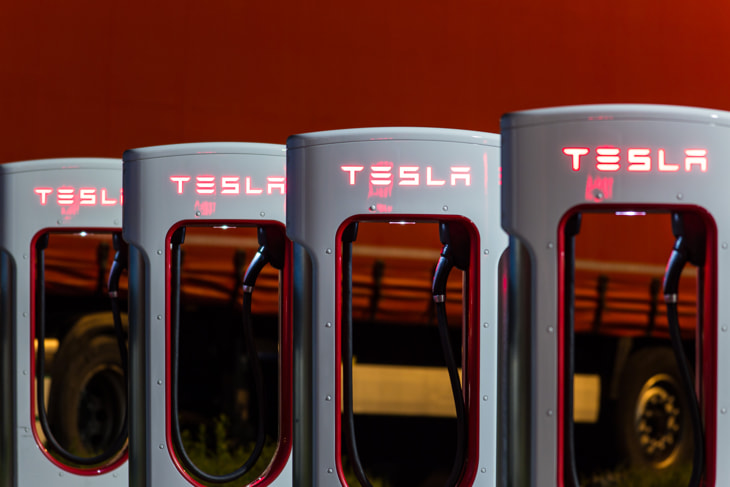
Depending on your method of charging, it can take between 45 minutes on a public Tesla Supercharger station to several days (on a standard 3-pin 120 volt outlet) to fully charge it.
Most Tesla users charge their car on a 240 volt outlet – the same kind of high-voltage outlet used for washers and dryers. On these, it takes around 8 to 12 hours to fully charge.
If you plan on using your Tesla Model 3 primarily as a commuter vehicle for going to work, buying groceries, and the occasional Sunday drive, it’s not difficult to get used to the idea of plugging in your Tesla as soon as you get home, and letting it charge overnight.
In fact, it might be even more convenient than a regular gasoline car since you don’t have to go to a gas station to refuel. Just plug it in overnight, and you get to enjoy the “full tank of gas” feeling each morning.
For longer trips though, such as visiting your in-laws in a different province, you do need to consider how and when you’re going to recharge your Tesla. Thankfully, there is a growing number of Tesla Superchargers and third party chargers coming online in 2022.
As time goes on and EVs become more popular, charging your Tesla on the go will become easier and more convenient.

But how does it perform in our cold, Canadian winters?
Winter temperatures do have a negative effect on battery ranges. You may have experienced it yourself with your phone; its battery doesn’t last nearly as long in cold temperatures.
According to driveteslacanada.ca, the colder it gets, the lower the range and efficiency of the battery. At -30C – like locals regularly experience during winter in Winnipeg – you can expect to see up to a 30% decrease in range and efficiency.
But is it actually that bad in real life? Does it turn your Tesla into a useless hunk of metal? Absolutely not!
Again, let’s take the base Tesla Model 3 model’s 50 kWh battery, with its EPA-estimated range of 430 – 438 km. For the sake of this example, let’s assume that its real-life range is closer to 350km per charge.
A 30% reduction of range in -30C winter conditions would mean a range of 245 km.
Again, if you’re mostly using your Tesla just to commute around your city, this really isn’t such a big deal. Unless you’re planning on going on a significantly long road trip, the cold won’t bother your Tesla too much.
How does the Tesla Model 3 battery pack compare to other EVs
In July of 2021, “What Car?” ran a battery range, real-life test of the Tesla Model 3. The Tesla was pit against 9 rival entry level EVs.
The test compared the Tesla Model 3 with the larger, long-range 70 kWh battery. Although the M3 came in second place, the winning Ford Mustang Mach-E had a larger battery pack of 88 kWh.
The Tesla Model 3 however, had the best efficiency of all. And if both battery packs were to be of the same capacity, the Tesla would have easily won.
Tesla Model 3 performance 0-100 km/h
Electric cars used to be mocked by car enthusiasts as underpowered and sluggish. And since electric motors are far quieter than gasoline engines, they were very easy to underestimate at the time.
But have you ever seen a 0-100 km/h test of a Tesla Model 3? Watch this video clip and you’ll understand.
That’s right, even with its most basic model, the M3 is capable of going from 0-100 km/h in less than 5 seconds.
And the Tesla Model 3 Performance trim is even faster – it’s capable of 0-100 in 3.5 seconds.
How’s that possible?
It’s because the M3’s electric motors use direct torque. Unlike a gasoline-powered car, where the engine has to transfer power first to the transmission and then to the wheel (all the components in this system are called a “drivetrain”), an electric motor transfers power directly to the wheels.
An electric motor has no need for a transmission. In fact, the Tesla Model 3 has only 3 “gears”: forward, reverse, and neutral.
How does it compare to other EVs
According to an acceleration test performed by Inside Evs in 2021, the base trim Tesla Model 3 has a faster acceleration than most of its class competitors. This includes:
- the 2022 Chevrolet Bolt EV,
- the Nissan Leaf,
- the Kia Niro EV, and
- the 2021 Hyundai IONIQ – which the Tesla Model 3 vastly outclasses.
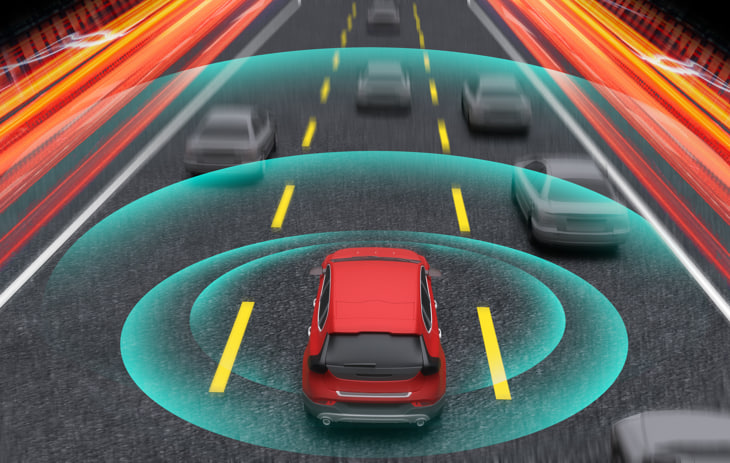
Tesla Model 3 driver assist tools (autopilot)
One of Tesla’s most attention-grabbing features has got to be the autopilot. The promise of being able to kick back, relax, and watch a movie as the car drives itself is certainly intoxicating.
But is the Tesla model 3 capable of delivering on that promise?
Yes and no. Here’s why.
First of all, it’s important to mention that autopilot doesn’t automatically come with the car. It’s an additional feature, purchased separately. The car, however, does come with all the cameras, radar, and sensors needed to make autopilot work.
Autopilot comes in 2 versions: Autopilot and Full Self-Driving. Here’s what you get with each.
Autopilot
Tesla calls its basic driver assist tools Autopilot. These include:
Traffic-aware cruise control: The autopilot matches your speed to that of the traffic around you. In other words, if the car in front of you slows down, the Tesla slows down too. And when it speeds up, your Tesla speeds up until you hit the maximum cruise control speed you’ve set.
Autosteer: If you’re driving on a highway, this feature keeps you centered in the lane and makes turns for you. It doesn’t work on city streets though.
Full Self-Driving (FSD)
In addition to Autopilot’s features, FSD includes the following:
Navigate on Autopilot (beta): This feature actively guides your Tesla from a highway’s on or off ramp, suggests lane changes, navigates intersections, automatically uses turn signals, and takes exits.
Auto lane change: When autosteer is enabled, this feature allows your Tesla to automatically change lanes.
Autopark: It lets your Tesla automatically parallel or perpendicular park with the touch of a button.
Summon: This lets you move your Tesla in and out of a tight space using the app or key.
Smart Summon: Allows your Tesla to move out of the parking spot, and drive itself to your current location in an around 60 – 65 meter radius.
Traffic and Stop Sign Control (beta): It identifies stop signs and traffic lights, causing your Tesla to slow to a stop.
What about real life?
But how well does autopilot work in real life?
According to independent testing, the Tesla Model 3’s decision making capabilities still have a lot of bugs to work out.
Traffic-Aware Cruise Control and autosteer do seem to work quite well, delivering as advertised. However, the FSD features still have a lot of bugs to work out.
Auto Lane Changes work quite well, though its decision making is not yet on par with human decision making.
Summon works as advertised, but Smart Summon has many glitches to overcome – it still relies heavily on its human operator. In our opinion, both versions of Summon serve more as fun gimmicks with situational uses, rather than regular usage features.
Autopark works in certain, ideal situations. Navigate on Autopilot, as well as Traffic and Stop Sign Control are still in beta and active development.
But here’s the kicker: all of these features are only going to get better.
As the Tesla Model 3 website itself claims, “All new Tesla cars have the hardware needed in the future for full self-driving in almost all circumstances.”
All Teslas are capable of receiving software updates (just like your phone). And as the development team works out the software bugs and improves the self-driving algorithms, your Tesla will get smarter over time.
What about the other Teslas? Are they a better option than the Tesla Model 3? Check out our deep dive article on it here.
How does Tesla Model 3’s autopilot compare to other EVs?
While Tesla’s Autopilot features are nowhere near perfect, they are still the most powerful, robust, and feature-rich driver assist tools on the market in 2022.
Other cars are certainly closing the gap – especially the GM Cadillac CT6’s Super Cruise system and the Audi A8. It’s worth noting that neither are EVs, nor entry level vehicles.
As of early 2022, no entry level EV comes close to Tesla’s Autopilot features.
Tesla Model 3 ease of use and quality of life features
When it comes to overall user interface and experience, Tesla decided to take a minimalist approach. When you step into a Tesla, you won’t feel like you’re getting inside of a fighter jet. It’s more like stepping into an iPhone.
You won’t find nearly as many buttons and knobs as you would in a regular car. And, of course, you won’t be able to miss the eye-catching 15-inch touchscreen.
Not only does this screen serve as a GPS and a heads-up display, but it also controls most of the Tesla’s features, including:
- the radio,
- temperature,
- mirrors,
- steering wheel height,
- windshield wipers,
- interior lights, and
- even the glovebox.
It takes some getting used to it, especially when you’ve already committed so many of these features to muscle memory.
In addition, the screen serves as an entertainment center. Some of the most popular streaming services are integrated, like Netflix, Hulu, Twitch, Youtube, and Spotify.
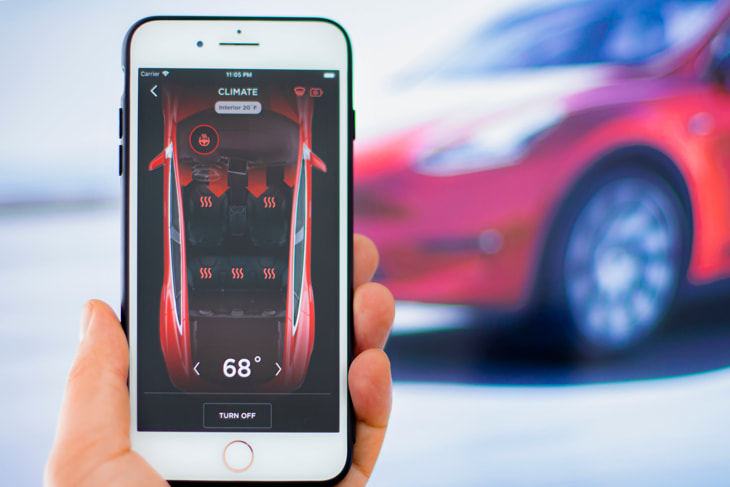
Multiple key options
The Tesla Model 3 also has 3 kinds of “keys” – a Tesla key card, a key fob, and your phone via the Tesla mobile app.
With the keycard, all you need to do is scan it on the B-Pillar (the space that separates the driver’s window with the rear passenger’s window) and the door will lock or unlock.
The key fob works just like a keyless entry fob, letting you lock and unlock from far away. If you keep it in your pocket, it’ll automatically lock and unlock the car when you’re within 5 feet of the car.
And with the Tesla phone app, you can do a number of things, including:
- lock and unlock the car,
- check the battery level and range,
- manage climate control,
- defrost the car,
- request roadside assistance,
- use Summon and Smart Summon features, and
- much more.
Autopilot can be purchased directly from the app too, or you can just try it out for a month or 2 via its monthly subscription service. You can also check for new Tesla M3 software updates at any time.
How do Tesla Model 3’s ease of use features compare to other EVs?
User experience can be extremely subjective. So whether you love Tesla’s minimalistic design and its reliance on the touchscreen controls depends on your own personal taste.
If you’re looking for an experience that’s out of the ordinary, appreciate the philosophy of rethinking previously-set standards, and want to be at the forefront of innovation for the sake of innovation, you’ll love the Tesla Model 3 driving experience.
But if you prefer a more traditional driving experience, and you don’t want to fiddle with a touchscreen each time you want to open the glove compartment, then other EVs are probably more suited for your taste. The Nissan Leaf and Kia Niro EV might be better options.
Having said that, there’s a strong chance that Tesla’s approach to a touchscreen-heavy user experience and minimalistic interior design is a sign of things to come.
“A lot of it is playing ‘follow the leader,'” explained Ed Kim, vice president at AutoPacific in an interview with ABC News. “Tesla’s Model S established the idea that a premium EV has a giant screen. There can be a strong tendency to emulate your benchmark. Right now Tesla is the benchmark.”
In fact, the Mustang Mach-e, the Polestar 2, and even the Kia EV6 are already mimicking Tesla’s giant touchscreen controls and minimalistic aesthetics.

Is the 2022 Tesla Model 3 the smartest EV car on the market?
In short, yes. This table shows comparisons with the competition, and Tesla comes out very much on top.
| 2022 Tesla Model 3 – RWD Standard Range Plus (60 kWh) |
2021 Nissan Leaf e+ (62 kWh) | 2021 Kia Niro EV (64 kWh) |
2021 Ford Mustang Mach-E Route 1 ER RWD (98.8 kWh) |
|
|---|---|---|---|---|
| Battery performance and range | 422 km | 364 km | 385 km | 491 km |
| Acceleration 0-100 km/h | Around 5.3 seconds | Around 6.5 seconds | Around 7.5 seconds | Around 6.2 seconds |
| Driver assist tools | * Traffic aware cruise control * Autosteer * Navigate on autopilot * Auto lane change * Autopark * Summon * Smart summon * Traffic and stop sign control |
* Collision detection * Blind spot detection * Traffic aware cruise control * Lane centering |
* Forward collision warning * Forward collision-avoidance-assist * Blind spot collision warning * Traffic aware cruise control * Lane centering * Driver attention warning |
* Blind spot detection * Lane centering * Speed sign recognition * Evasive steering assist * Traffic aware cruise control * Park assist * Future implementation of BlueCruise hands-free highway driving |
| Quality of life features | * 15″ touch screen that controls most features of the vehicle * 3 different kinds of “keys” * Tesla app that turns phone into key, additional form of feature control, remote operations |
* 8″ customizable touch screen * Nissan connect EV and services app * Keyless fob |
* 10.25″ navigation system display * Kia Connect app with climate control, vehicle locator and charging |
* 15.5″ touchscreen * FordPass Connect with remote climate control, lock and unlock, start/ stop vehicle, and car diagnostic tools |
| MSRP | $59,990 | $44,298 – $52,898 | $44,995 – $54,695 | Starting at $64,495 |
Thanks to its impressive range (even on the base model), multiple charging options, constant software updates, and price, it really is a modern engineering miracle.
There’s definitely a learning curve involved if you’re transitioning from a gasoline-powered car, and long distance travel does involve some planning around charging stations. But it’s already a fantastic commuter/mid-range vehicle, especially if you live in a large city.
When it comes to comparing range and price, you get what you pay for. As the MSRP of these vehicles increase, you’ll get a longer range from your card.
Your turn
Do you agree with our conclusion? Or do you think that a different EV deserves to be called the smartest? Let us know in the comments.
FAQ
What smart features does a Tesla Model 3 offer?
It’s hard to mention all of them. A few of the most outstanding ones include its best-in-class battery range, the plethora of driver assistant tools, and the frequent addition of software updates and additional features. You can read the section above for more information on these features.
What other all electric smart cars are there available in Canada?
There is a range of 40-odd EVs available in Canada right now. Some of the most popular ones include the Toyota Prius, Hyundai Ioniq, and Nissan LEAF. If you look at our comparison table, you’ll see how some of these options compare against the Tesla M3.
How much does a Tesla Model 3 cost?
Depending on the trim, it can cost $58,610 for the base model and up to $76,990 for the Model 3 Performance version. But those prices vary, depending on the additional add-ons and features you decide to buy.
creditcardGenius is the only tool that compares 126+ features of 231 Canadian credit cards using math-based ratings and rankings that respond to your needs, instantly. Take our quiz and see which of Canada's 231 cards is for you.






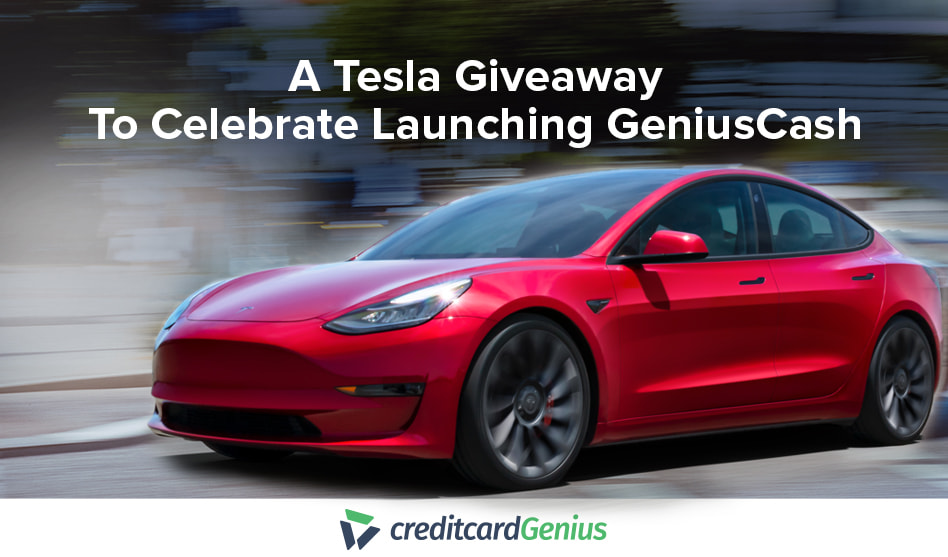
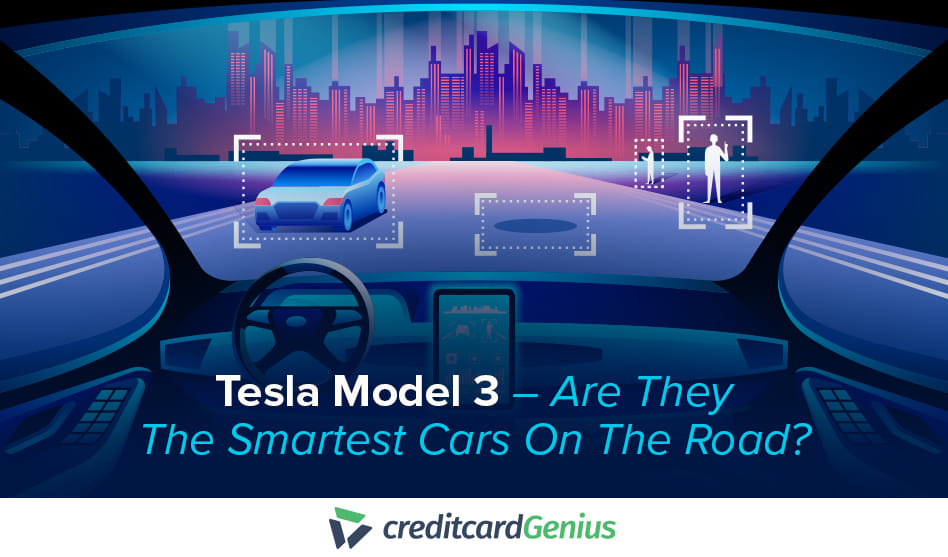


 GC:
GC: 
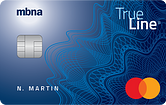













.png)




















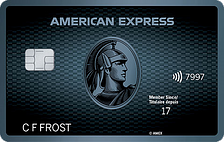
 $100 GeniusCash + Earn up to 15,000 Welcome Bonus Membership Rewards® Points.*
$100 GeniusCash + Earn up to 15,000 Welcome Bonus Membership Rewards® Points.*
Comments
Leave a comment
Required fields are marked with *. Your email address will not be published.
Showing 6 comments